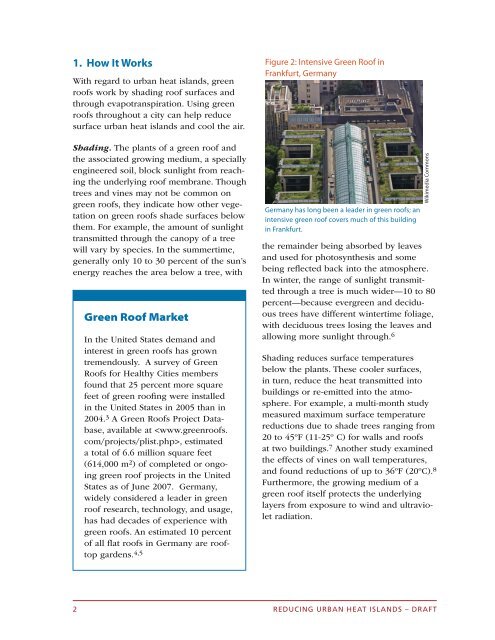Reducing Urban Heat Islands: Compendium of Strategies - Green ...
Reducing Urban Heat Islands: Compendium of Strategies - Green ...
Reducing Urban Heat Islands: Compendium of Strategies - Green ...
Create successful ePaper yourself
Turn your PDF publications into a flip-book with our unique Google optimized e-Paper software.
1 How It Works<br />
With regard to urban heat islands, green<br />
ro<strong>of</strong>s work by shading ro<strong>of</strong> surfaces and<br />
through evapotranspiration. Using green<br />
ro<strong>of</strong>s throughout a city can help reduce<br />
surface urban heat islands and cool the air.<br />
Shading. The plants <strong>of</strong> a green ro<strong>of</strong> and<br />
the associated growing medium, a specially<br />
engineered soil, block sunlight from reaching<br />
the underlying ro<strong>of</strong> membrane. Though<br />
trees and vines may not be common on<br />
green ro<strong>of</strong>s, they indicate how other vegetation<br />
on green ro<strong>of</strong>s shade surfaces below<br />
them. For example, the amount <strong>of</strong> sunlight<br />
transmitted through the canopy <strong>of</strong> a tree<br />
will vary by species. In the summertime,<br />
generally only 10 to 30 percent <strong>of</strong> the sun’s<br />
energy reaches the area below a tree, with<br />
2<br />
<strong>Green</strong> Ro<strong>of</strong> Market<br />
In the United States demand and<br />
interest in green ro<strong>of</strong>s has grown<br />
tremendously. A survey <strong>of</strong> <strong>Green</strong><br />
Ro<strong>of</strong>s for Healthy Cities members<br />
found that 25 percent more square<br />
feet <strong>of</strong> green ro<strong>of</strong>ng were installed<br />
in the United States in 2005 than in<br />
2004. 3 A <strong>Green</strong> Ro<strong>of</strong>s Project Database,<br />
available at , estimated<br />
a total <strong>of</strong> 6.6 million square feet<br />
(614,000 m 2 ) <strong>of</strong> completed or ongoing<br />
green ro<strong>of</strong> projects in the United<br />
States as <strong>of</strong> June 2007. Germany,<br />
widely considered a leader in green<br />
ro<strong>of</strong> research, technology, and usage,<br />
has had decades <strong>of</strong> experience with<br />
green ro<strong>of</strong>s. An estimated 10 percent<br />
<strong>of</strong> all fat ro<strong>of</strong>s in Germany are ro<strong>of</strong>top<br />
gardens. 4,5<br />
Figure 2: Intensive <strong>Green</strong> Ro<strong>of</strong> in<br />
Frankfurt, Germany<br />
Germany has long been a leader in green ro<strong>of</strong>s; an<br />
intensive green ro<strong>of</strong> covers much <strong>of</strong> this building<br />
in Frankfurt.<br />
the remainder being absorbed by leaves<br />
and used for photosynthesis and some<br />
being refected back into the atmosphere.<br />
In winter, the range <strong>of</strong> sunlight transmitted<br />
through a tree is much wider—10 to 80<br />
percent—because evergreen and deciduous<br />
trees have different wintertime foliage,<br />
with deciduous trees losing the leaves and<br />
allowing more sunlight through. 6<br />
Shading reduces surface temperatures<br />
below the plants. These cooler surfaces,<br />
in turn, reduce the heat transmitted into<br />
buildings or re-emitted into the atmosphere.<br />
For example, a multi-month study<br />
measured maximum surface temperature<br />
reductions due to shade trees ranging from<br />
20 to 45ºF (11-25º C) for walls and ro<strong>of</strong>s<br />
at two buildings. 7 Another study examined<br />
the effects <strong>of</strong> vines on wall temperatures,<br />
and found reductions <strong>of</strong> up to 36ºF (20ºC). 8<br />
Furthermore, the growing medium <strong>of</strong> a<br />
green ro<strong>of</strong> itself protects the underlying<br />
layers from exposure to wind and ultraviolet<br />
radiation.<br />
REDUCING URBAN HEAT ISLANDS – DRAFT<br />
Wikimedia Commons

















